
The Solar-Terrestrial Centre of Excellence (STCE) is a collaborative network of the Belgian Institute for Space Aeronomy, the Royal Observatory of Belgium and the Royal Meteorological Institute of Belgium.
 |
Published by the STCE - this issue : 18 Apr 2014. The Solar-Terrestrial Centre of Excellence (STCE) is a collaborative network of the Belgian Institute for Space Aeronomy, the Royal Observatory of Belgium and the Royal Meteorological Institute of Belgium. |
| Archive of the newsletters | Subscribe to this newsletter by mail |
During the morning hours of Saturday 12 April, a flare took place near the Sun's southeast limb. It started at 07:15UT and reached its maximum (C5.0) at 07:27UT, then gradually decreased in intensity to end at 08:07UT. It occurred near the trailing part of NOAA 2035, which had shown some low level (C-class) flaring activity during the previous 2 days while rounding the east limb.
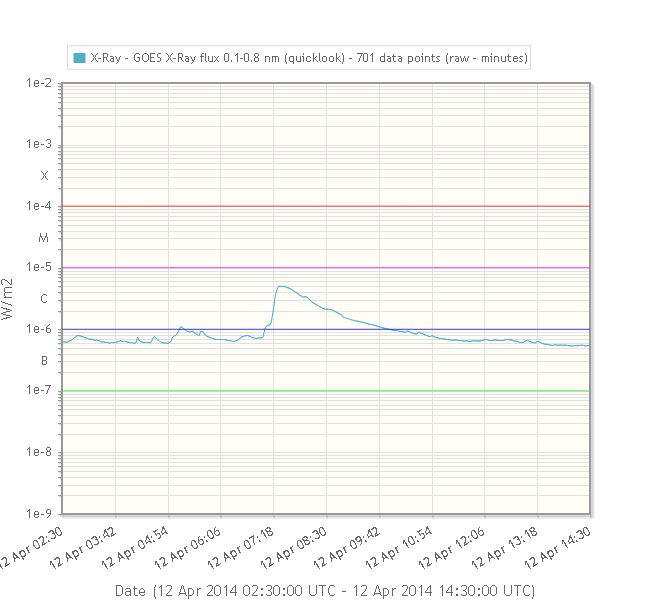
This movie at http://youtu.be/uP1eWUS4JzA shows the evolution of the flare and associated prominence eruption in successively hotter temperature bands: AIA 304 (80.000 degrees, transition region), AIA 171 (700.000 degrees, showing the upper transition zone/lower corona), and AIA 131. The latter is designed to show the hot parts in the corona, i.e. flares, and shows the solar atmosphere at several million degrees. AIA 131 also has a passband at around 400.000 degrees. That's why the relatively cool material of the ejected prominence is also somewhat visible in this filter.
The mosaic underneath shows some stills from this movie, taken at regular intervals and in the three SDO-filters. The flare itself is best and earliest visible in AIA 131 (hottest), whereas the series of post-flare coronal loops ("arcade") gradually become better visible in the cooler AIA 171 band. However, none of these filters can compete with the "cold" AIA 304 band when it comes to imaging the erupting prominence. Though material is clearly ejected, it can also be seen that material is returning to the solar surface along the magnetic field lines.
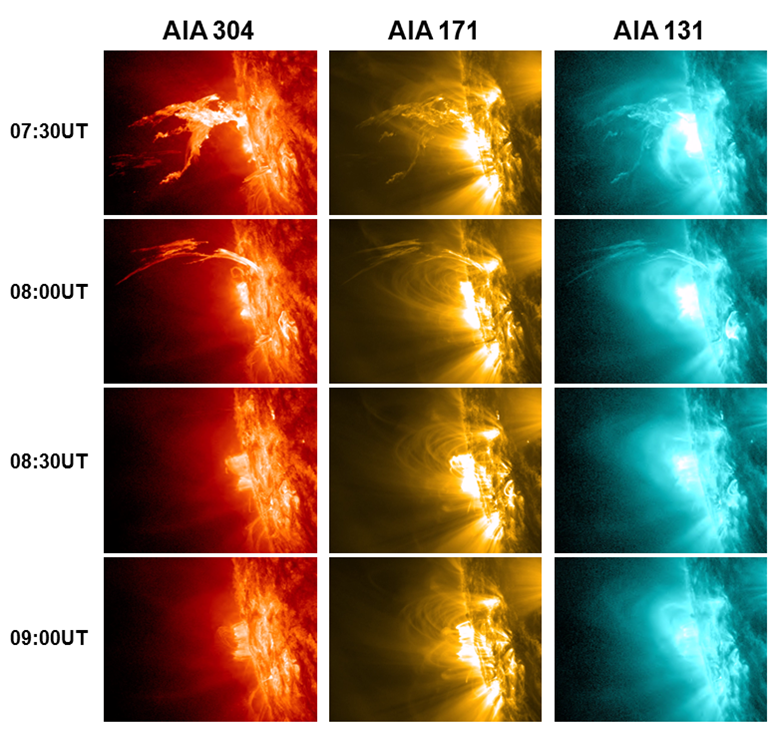
Aside the combination clip, the movie also contains coronagraphic imagery from SOHO/LASCO. The ejected material can be seen as a narrow coronal mass ejection (CME) with no Earth directed component. CACTUS indicates this CME had a speed near 500 km/s. The imagery also seems to show that some of the material which was already a few solar radii away from the Sun, eventually still returned to the solar surface. Indeed, it's not so easy to escape the Sun's gravity!
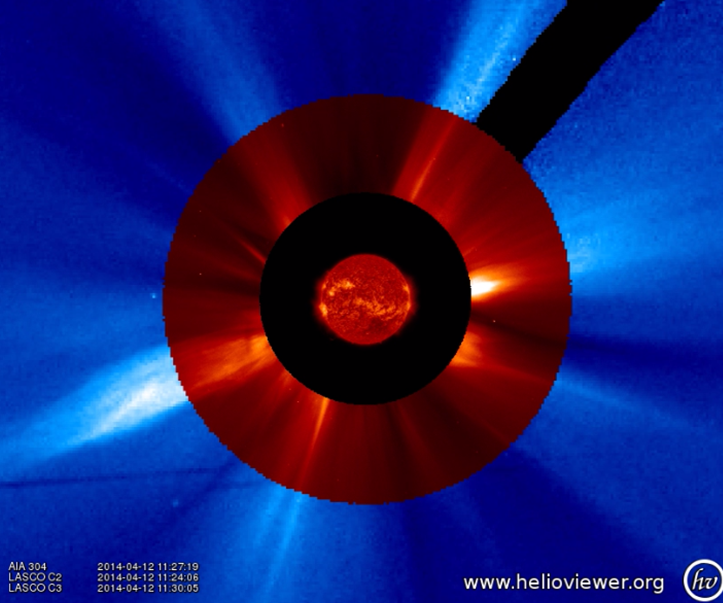
Credits - Data and imagery taken from SDO (http://sdo.gsfc.nasa.gov/), SOHO (http://sohowww.nascom.nasa.gov/home.html), CACTUS (http://www.sidc.oma.be/cactus/out/latestCMEs.html), and (J)Helioviewer (http://helioviewer.org/).
If you are asking yourself how radio antennas and solar science are linked, the STCE workshop is something for you. All secrets about modelling of antenna and calibration of radio instruments will be revealed.
Welcome on June 6 at the Space Pole for a full day workshop with free lunch and coffee, no registration fee.
http://www.stce.be/annualmeeting/2014/calibration.php
Following an excellent response to the call for session proposals issued in January, the ESWW11 Programme Committee is pleased to present you 15 sessions. Some keywords: spacecraft - ionosphere and GNSS - planetary systems - numerical SW predictions - geospace - solar particles - enterprises - SW science, engineering and applications - space based observations - space climate .
You are invited to contribute to one or more sessions with an oral or poster presentation. We have a new session format for the 2014 edition. Each session is split in two parts: a sequence of oral presentations for an audience sitting in the session room followed by the first-class poster programme in the poster area where people walk around and where the discussion and interaction between people is emphasized.
http://www.stce.be/esww11
We counted 24 C-class flares linked with an active region. The chart below gives an overview of the C-flaring activity of each active region per day. The record holder was NOAA AR 2035 (old AR 2010) active from April 9-12 with 14 C-flares on its counter including the strongest flare of this week: a C9.4, peak at 11:24 UT on April 11.
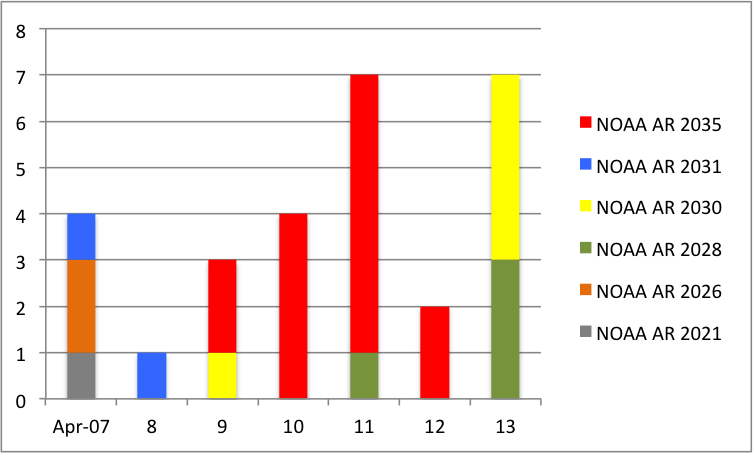
A southern coronal hole which was prominent present in SDO/AIA 193 images reached the central meridian on April 8. The hole spanned 50 degrees in longitude and 25 degrees in latitude and was centred near S45. This hole has grown considerably since last rotation.
Another recurrent, but smal northern coronal hole also reached the central meridian on April 8.
No clear fingerprint in ACE data of the coronal holes could be identified.
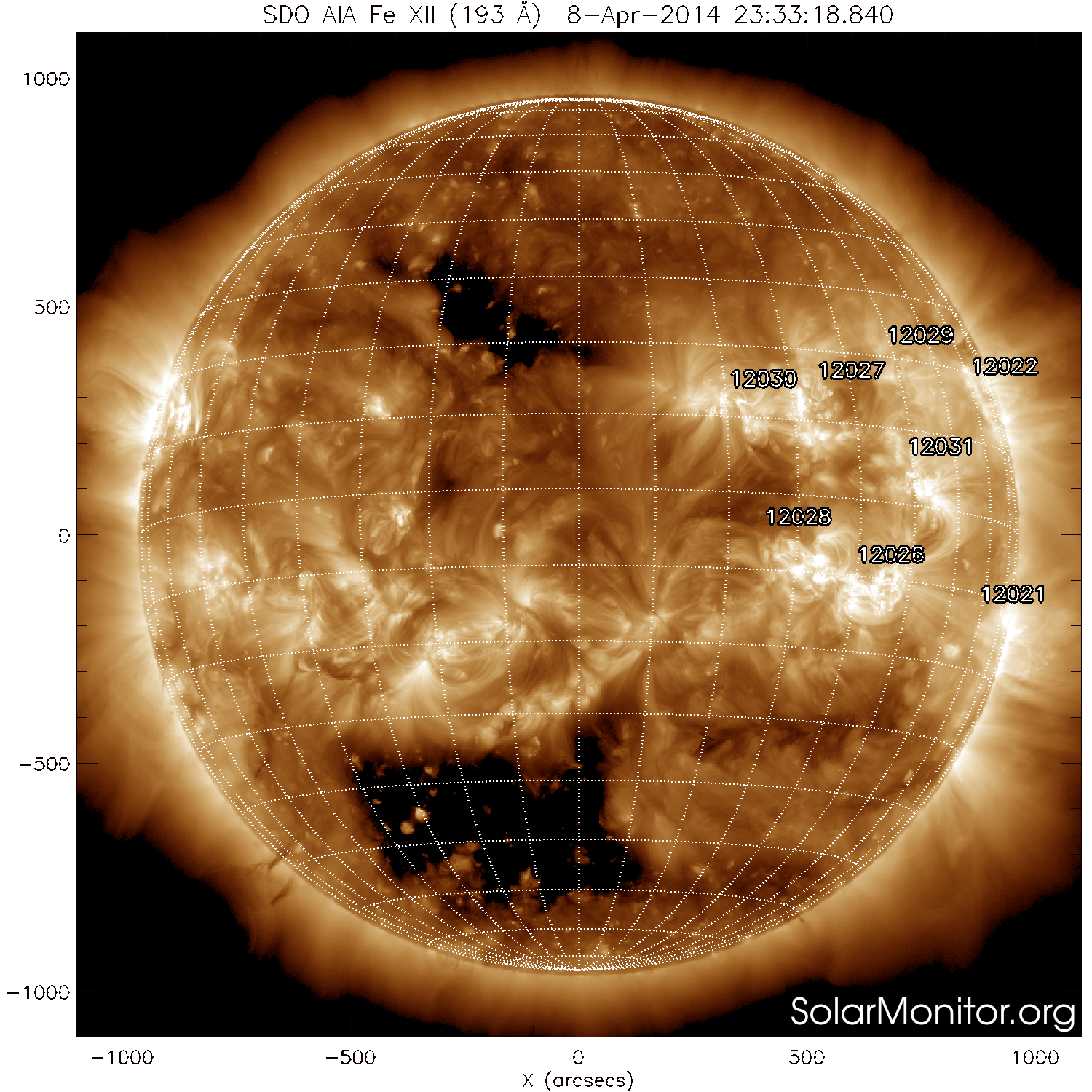
Unsettled to active magnetic conditions (both local K at Dourbes and NOAA planetary Kp) were observed on April 7. This was related to the trailing part of the interplanetary coronal mass ejection (ICME) passing ACE on April 5 and 6. The ICME could be possibly linked to the CMEs leaving the Sun on April 1 and/or April 2.
On April 11-12, a magnetic cloud passed the L1 point. A magnetic cloud is an ICME with a rotating magnetic flux rope. In the ACE data you see that the angle Phi rotates from 90 degrees to 270 degrees. Phi is the angle between the radial and the magnetic field at 1AU. In the cartoon below Phi is drawn for a typical solar wind speed of 400 km/s. In our case, the magnetic field vector rotates from left (90 degrees) to right (270 degrees). The link with a solar event is not clear.
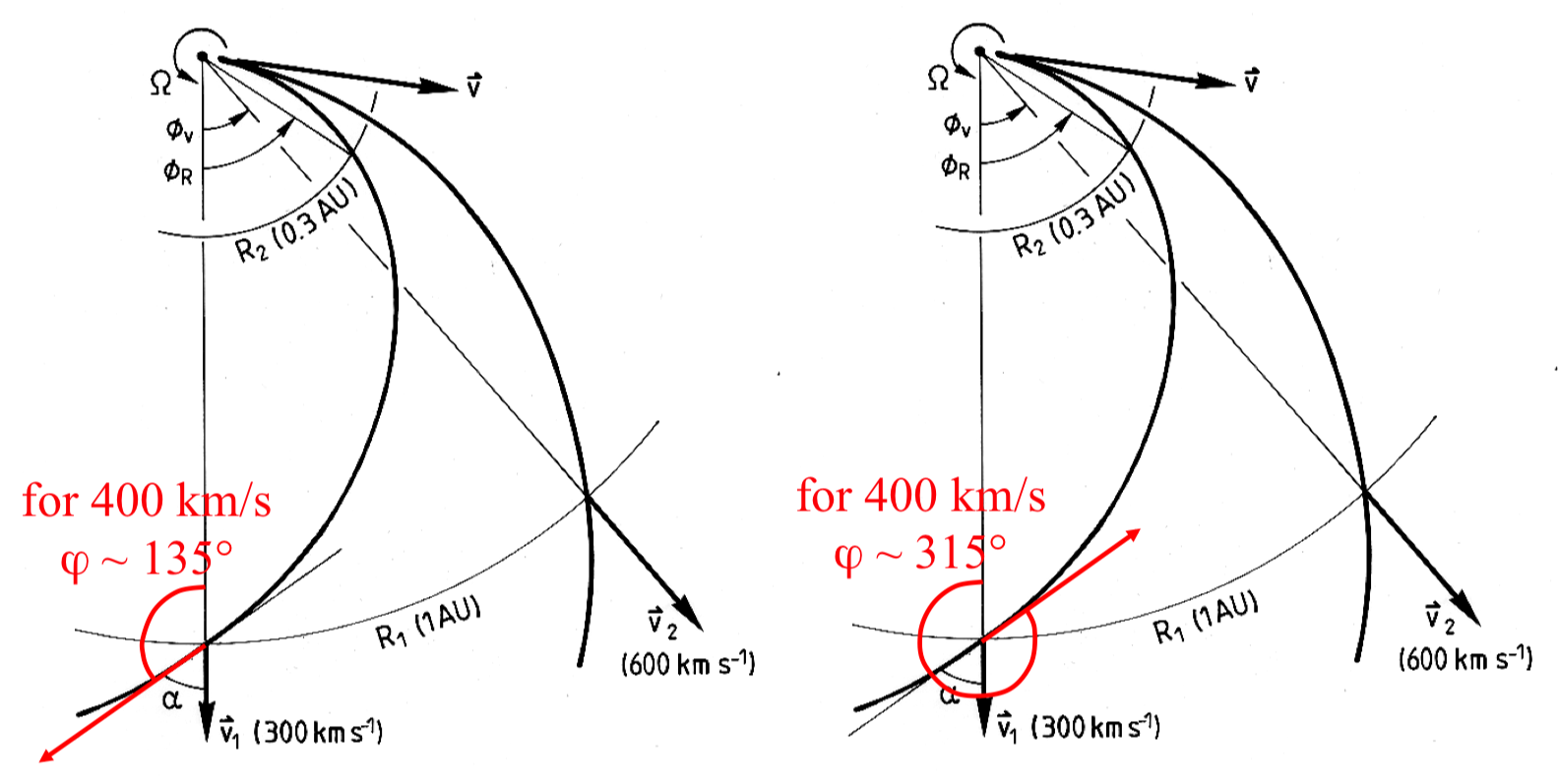

The negative excursion of the Bz component of the IMF resulted during the first half of the UT day of April 12 locally (Dourbes) in active conditions (K=4) and even a time slot of K=5 at planetary levels.
Solar activity was low this week. The highest level flare was a C9.4 flare, on Friday 11th.
In order to view the activity of this week in more detail, we suggest to go to the following website from which all the daily (normal and difference) movies can be accessed: http://proba2.oma.be/ssa.
This page also lists the recorded flaring events.
A weekly overview movie can be found here: http://proba2.oma.be/swap/data/mpg/movies/WeeklyReportMovies/WR211_Apr07_Apr13/weekly_movie_2014_04_07.mp4 (SWAP week 211).
Details about some of this week’s events can be found further below.
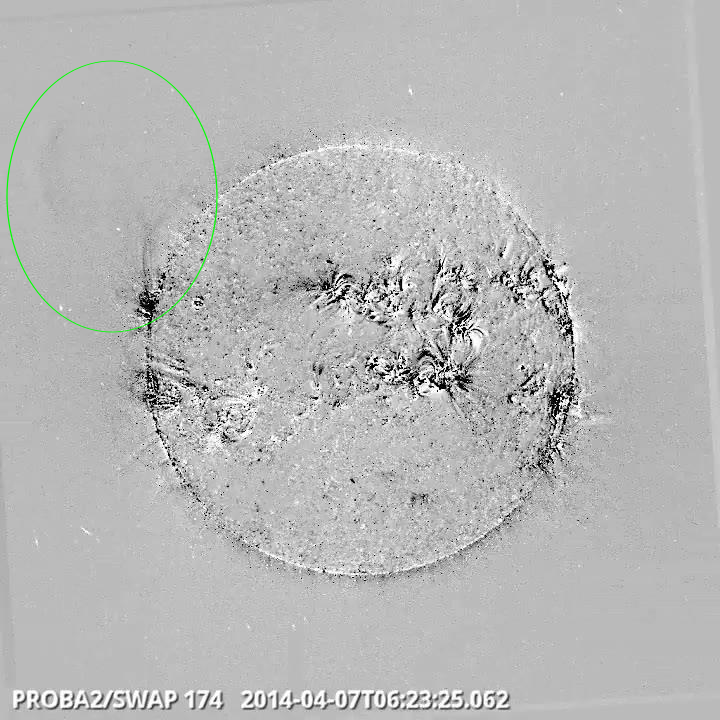
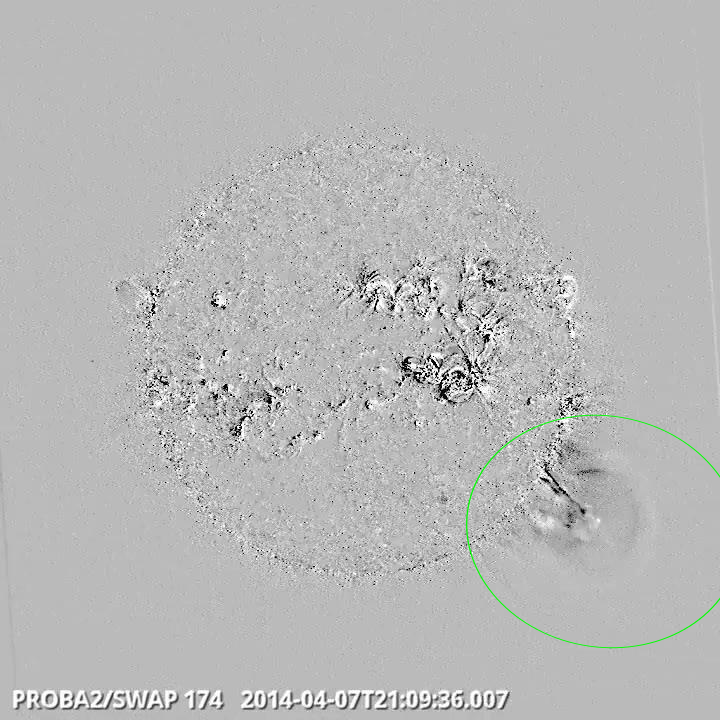
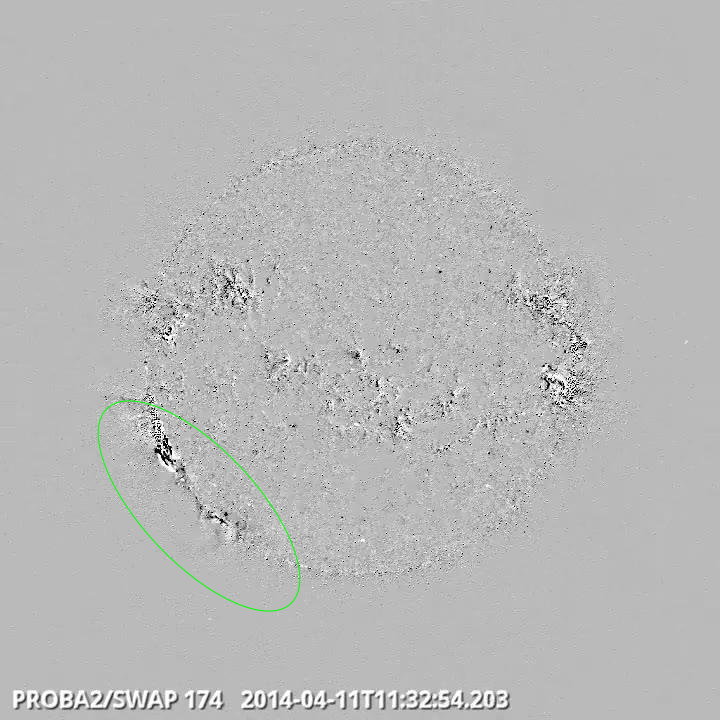
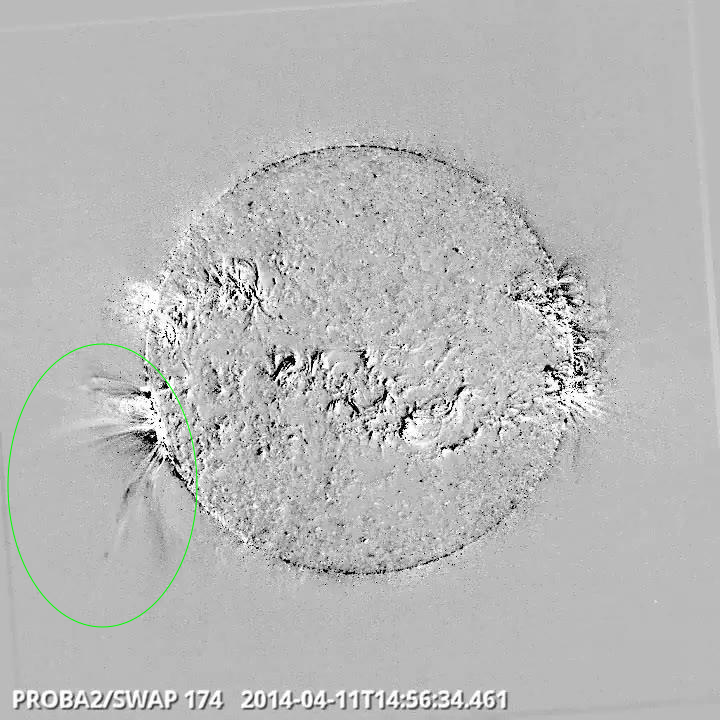
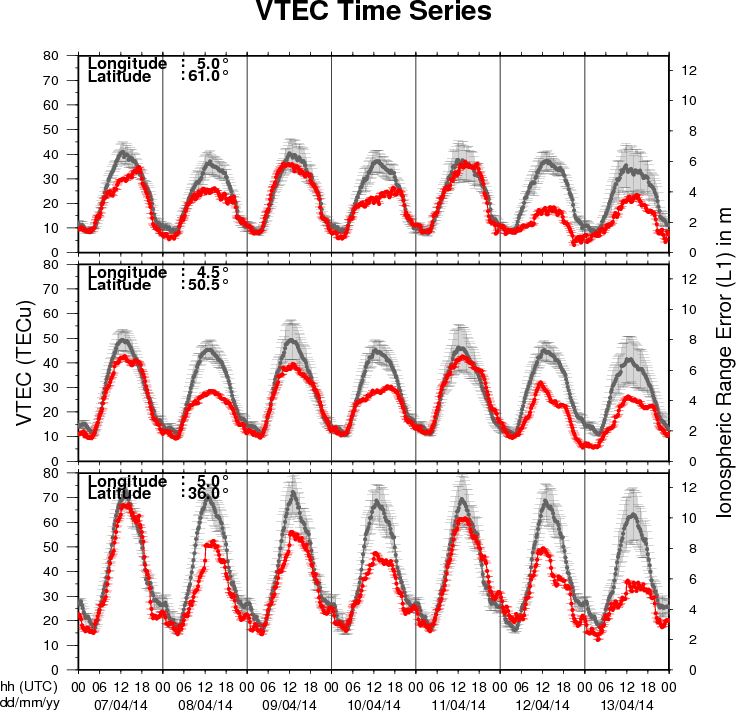
The figure shows the time evolution of the Vertical Total Electron Content (VTEC) (in red) during the last week at three locations:
a) in the northern part of Europe(N61°, 5°E)
b) above Brussels(N50.5°, 4.5°E)
c) in the southern part of Europe(N36°, 5°E)
This figure also shows (in grey) the normal ionospheric behaviour expected based on the median VTEC from the 15 previous days.
The VTEC is expressed in TECu (with TECu=10^16 electrons per square meter) and is directly related to the signal propagation delay due to the ionosphere (in figure: delay on GPS L1 frequency).
The Sun's radiation ionizes the Earth's upper atmosphere, the ionosphere, located from about 60km to 1000km above the Earth's surface.The ionization process in the ionosphere produces ions and free electrons. These electrons perturb the propagation of the GNSS (Global Navigation Satellite System) signals by inducing a so-called ionospheric delay.
See http://stce.be/newsletter/GNSS_final.pdf for some more explanations ; for detailed information, see http://gnss.be/ionosphere_tutorial.php
Start : 2014-04-27 - End : 2014-05-02
The EGU General Assembly 2014 will bring together geoscientists
from all over the world to one meeting covering all disciplines of
the Earth, planetary and space sciences. The EGU aims to provide a
forum where scientists, especially early career researchers, can
present their work and discuss their ideas with experts in all
fields of geosciences.
Start : 2014-06-10 - End : 2014-06-11
The STCE workshop 'Inter-Calibration and Degradation of EUV
Instruments' aims at understanding the differences observed between
the various instruments observing in the SXR-EUV range and at
analyzing the ageing effects that affect their results. It targets
imagers as well as spectrometers and photometers.
The workshop will be followed by two days of working sessions
(June 12-13) organized by the Solar EUV Irradiance Working Group
(also supported by the STCE). These working sessions are in the
continuity of similar events organized in 2011, 2012 and 2013, but
they are open to new participants and you are welcome to join if
you are interested.
Website:
http://www.stce.be/euvworkshop2014/
Start : 2014-06-19 - End : 2014-06-20
During the summer of 2014 DTU Space will host the 3rd Swarm
Science Meeting, sponsored by the European Space Agency, ESA
. This meeting will take place at
the IDA Conference Centre in Copenhagen on June 19th to 20th 2014
and is open to the science community at large.
Website:
http://congrexprojects.com/2014-events/Swarm/home
The STCE Annual Report 2012 is a compilation of the activities done in 2012 within the frame of the Solar-Terrestrial Centre of Excellence (STCE). This report continues the style from the previous edition. Hence, as it is targeting a more general public, it presents only a selection of the 2012-activities in easy-to-digest summaries. These summaries emphasize the intense collaboration between the institutes at the Space Pole, as well as with our external partners. We hope you enjoy this report, which features articles on the evolution of the solar activity, the 9th European Space Weather Week, PROBA2, Integrated Water Vapor observations, SIMBA the nanosatellite, user applications such as STAFF, LIDAR, and ionospheric models, and much more... Happy reading!
http://www.spaceweather.eu/en/repository/show?id=494
http://www.spaceweather.eu/en/repository/show?id=492
http://www.spaceweather.eu/en/repository/show?id=497
http://www.spaceweather.eu/en/repository/show?id=498